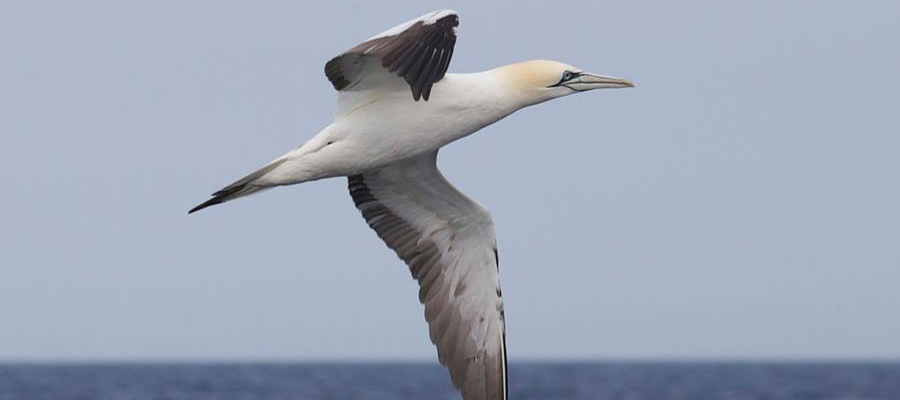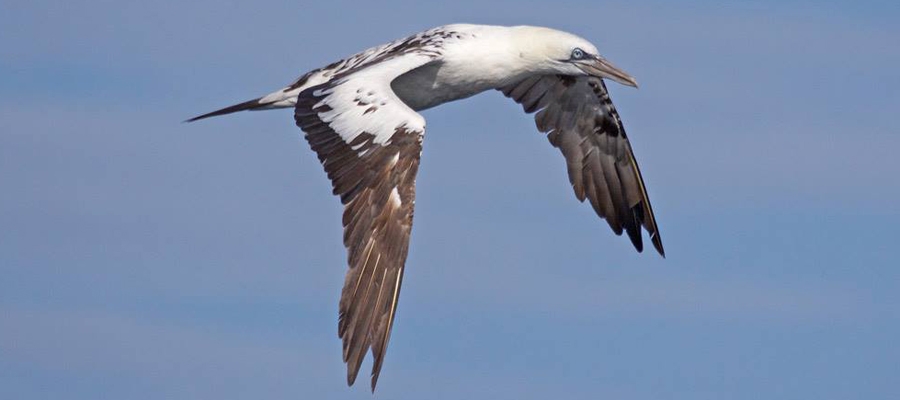Northern Gannet
(Morus bassanus)
Northern Gannets are commonly seen during our whale watching trips at all times of the year but are most abundant in Spring, Fall, and Winter. During the height of Summer, it is mostly Juvenile birds that are seen in our waters.
The lone representative of the Booby family in Massachusetts area, the Northern Gannet is without a doubt one of the most spectacular seabirds you might encounter on a whale watching trip to Stellwagen Bank or Jeffrey’s Ledge.
They are huge (up to a 70-inch wingspan… much bigger than most Gulls) with a striking black-and-white plumage. Immature and Juvenile Gannets are various combinations of brown-and-white but share the adult’s great size and distinctive flight.
Gannets are actually most abundant in the late fall and winter but are still quite common during the Spring and early summer. During the mid-summer months, most of the adult Gannets are busy nesting on steep cliffs along the rugged eastern Canadian coast. Juveniles who have not reached maturity may stay at sea all summer long so Gannet sightings are possible at any time of year.
Gannets cruise high over the water when feeding, using their keen vision to look for schools of fish beneath the ocean’s surface. When an appetizing fish is spotted the Gannet will begin a steep, head-first descent which may reach speeds of over 80 mph! Obviously, hitting the water at this speed could do damage to the bird if it hit the surface awkwardly and so the Gannets have developed into expert divers that rival any Olympic athlete. Just before the Gannet hits the surface it stretches its wings straight back so that the wing-tips form a point behind the bird. Now the Gannet is shaped like a giant dart, only it is pointed at both ends, as it plunges head-first into the sea. If the dive is performed right (and it almost always is) only a small plume of water splashes up from where the Gannet enters the water.
ADAPTATIONS TO LIFE AT SEA: TAKING FLIGHT
Taking Flight Gannets have very long wings compared to the wing’s width. This is called a large “aspect ratio”. Birds with a large aspect ratio such as Gannets, Shearwaters, and Albatrosses are natural-born gliders. Birds with small aspect ratios, such as sparrows or ducks, need to beat their wings furiously in order to maintain lift and therefore flight. Seabirds like Gannets, on the other hand, can glide for miles with only minimal flapping.
The wings of many seabirds are shaped just like the wings of an airplane (an “aerofoil”) and, just like an airplane that needs to build up speed on a runway during take-off, these gliding-birds often need to run over the surface of the water in order to get enough air flowing passed their wings to generate the lift they need to fly. In windless conditions, or when they have bellies full of fish, birds with large aspect ratios such as the Northern Gannets may be unable to take-off and must, therefore resort to diving in order to escape approaching boats or aerial predators such as Jaegers.
Gannets have even been known to starve to death when windless conditions last for days or weeks. Without any wind blowing across the water they simply can’t get the lift they need to become airborne and thus are unable to hunt for food. Again, birds with a small aspect ratio can create a lot of lift simply by flapping their wings quickly… notice how many ducks can simply “spring” off the surface of a still pond without getting a running start. Birds such as these (small aspect ratio birds) expend a lot of energy during flight and therefore don’t often fly great distances except during migration. For seabirds which need to traverse hundreds of miles of open sea each day in order to find widely scattered food it usually pays to be able to glide effortlessly (long aspect ratio) even if it makes for a more difficult take-off.



